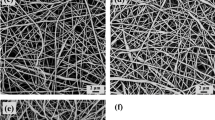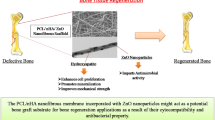Abstract
Poly(lactide-co-glycolide) (PLGA) nanofibrous composite scaffolds having nano-hydroxyapatite particles (HAp) in the fibers were prepared by electrospinning of PLGA and HAp with an average diameter of 266.6 ± 7.3 nm. Microscopy and spectroscopy characterizations confirmed integration of the crystalline HAp in the scaffolds. Agglomerates gradually appeared and increased on the fiber surface along with increase of the HAp concentration. In vitro mineralization in a 5 × simulated body fluid (SBF) revealed that the PLGA/HAp nanofibrous scaffolds had a stronger biomineralization ability than the control PLGA scaffolds. Biological performance of the nanofibrous scaffolds of the control PLGA and PLGA with 5 wt% HAp (PLGA/5HAp) was assessed by in vitro culture of neonatal mouse calvaria-derived MC3T3-E1 osteoblasts. Both types of the scaffolds could support cell proliferation and showed sharp increase of viability until 7 days, but the cells cultured on the PLGA/5HAp nanofibers showed a more spreading morphology. Despite the similar level of the cell viability and cell number at each time interval, the alkaline phosphatase secretion was significantly enhanced on the PLGA/5HAp scaffolds, indicating the higher bioactivity of the as-prepared nano-HAp and the success of the present method for preparing biomimetic scaffold for bone regeneration.








Similar content being viewed by others
References
Webster TJ, Ahn ES. Nanostructured biomaterials for tissue engineering bone. Adv Biochem Eng Biotechnol. 2007;103:275–308.
Murugan R, Ramakrishna S. Development of nanocomposites for bone grafting. Compos Sci Technol. 2005;65:2385–406.
Boyle WJ, Simonet WS, Lacey DL. Osteoclast differentiation and activation. Nature. 2003;423:337–42.
Jose MV, Thomas V, Johnson KT, Dean DR, Nyalro E. Aligned PLGA/HA nanofibrous nanocomposite scaffolds for bone tissue engineering. Acta Biomater. 2009;5:305–15.
Sopyan I, Mel M, Ramesh S, Khalid KA. Porous hydroxyapatite for artificial bone applications. Sci Technol Adv Mater. 2007;8:116–23.
Rose FRAJ, Oreffo ROC. Bone tissue engineering: hope vs hype. Biochem Biophys Res Commun. 2002;292:1–7.
Burg KJL, Porter S, Kellam JF. Biomaterial developments for bone tissue engineering. Biomaterials. 2000;21:2347–59.
Hutmacher DW. Scaffolds in tissue engineering bone and cartilage. Biomaterials. 2000;21:2529–43.
Huang ZM, Zhang YZ, Kotaki M, Ramakrishna S. A review on polymer nanofibers by electrospinning and their applications in nanocomposites. Compos Sci Technol. 2003;63:2223–53.
Sill TJ, von Recum HA. Electro spinning: applications in drug delivery and tissue engineering. Biomaterials. 2008;29:1989–2006.
Schreuder-Gibson H, Gibson P, Wadsworth L, Hemphill S, Vontorcik J. Effect of filter deformation on the filtration and air flow for elastomeric nonwoven media. Adv Filtr Sep Technol. 2002;15:525–37.
Bergshoef MM, Vancso GJ. Transparent nanocomposites with ultrathin, electrospun nylon-4,6 fiber reinforcement. Adv Mater. 1999;11:1362–5.
Wang XY, Drew C, Lee SH, Senecal KJ, Kumar J, Sarnuelson LA. Electrospun nanofibrous membranes for highly sensitive optical sensors. Nano Lett. 2002;2:1273–5.
Jing Z, Xu XY, Chen XS, Liang QZ, Bian XC, Yang LX, Jing XB. Biodegradable electrospun fibers for drug delivery. J Control Release. 2003;92:227–31.
Liang D, Hsiao BS, Chu B. Functional electrospun nanofibrous scaffolds for biomedical applications. Adv Drug Deliver Rev. 2007;59:1392–412.
Chronakis IS. Novel nanocomposites and nanoceramics based on polymer nanofibers using electrospinning process—a review. J Mater Process Technol. 2005;167:283–93.
Lao LH, Tan HP, Wang YJ, Gao CY. Chitosan modified poly(l-lactide) microspheres as cell microcarriers for cartilage tissue engineering. Colloid Surf B. 2008;66:218–25.
Tan HP, Wan L, Wu JD, Gao CY. Microscale control over collagen gradient on poly(l-lactide) membrane surface for manipulating chondrocyte distribution. Colloid Surf B. 2008;67:210–5.
Seal BL, Otero TC, Panitch A. Polymeric biomaterials for tissue or organ regeneration. Mater Sci Eng. 2001;34:147–230.
Zhang PB, Hong ZK, Yu T, Chen XS, Jing XB. In vivo mineralization and osteogenesis of nanocomposite scaffold of poly (lactide-co-glycolide) and hydroxyapatite surface-grafted with poly(l-lactide). Biomaterials. 2009;30:58–70.
Nelson JF, Stanford HG, Cutright DE. Evaluation and comparison of biodegradable substances as osteogenic agents. Oral Surg. 1977;43:836–43.
Hollinger JO. Preliminary report on the osteogenic potential of a biodegradable copolymer of polyactide (PLA) and polyglycolide (PGA). J Biomed Mater Res. 1983;17:71–82.
Zhao HG, Ma L, Gao CY, Wang JF, Shen JC. Fabrication and properties of injectable beta-tricalcium phosphate particles/fibrin gel composite scaffolds for bone tissue engineering. Mater Sci Eng C. 2009;29:836–42.
Gay S, Arostegui S, Lemaitre J. Preparation and characterization of dense nanohydroxyapatite/PLLA composites. Mater Sci Eng C. 2009;29:172–7.
Rizzi SC, Heath DT, Coombes AGA, Bock N, Textor M, Downes S. Biodegradable polymer/hydroxyapatite composites: surface analysis and initial attachment of human osteoblasts. J Biomed Mater Res. 2001;55:475–86.
Woo KM, Jun JH, Chen VJ, Seo J, Baek JH, Ryoo HM, Kim GS. Nano-fibrous scaffolding promotes osteoblast differentiation and biomineralization. Biomaterials. 2007;28:335–43.
Martinez E, Engel E, Planell JA, Samitier J. Effects of artificial micro- and nano-structured surfaces on cell behaviour. Ann Anat. 2009;191:126–35.
Deng XL, Sui G, Zhao ML, Chen GQ, Yang XP. Poly(l-lactic acid)/hydroxyapatite hybrid nanofibrous scaffolds prepared by electrospinning. J Biomater Sci Polym Ed. 2007;18(1):117–30.
Sui G, Yang X, Mei F, Hu X, Chen G, Deng X, Ryu S. Poly-l-lactic acid/hydroxyapatite hybrid membrane for bone tissue regeneration. J Biomed Mater Res A. 2007;82(2):445–54.
Kim HW, Lee HH, Knowles JC. Electrospinning biomedical nanocomposite fibers of hydroxyapaite/poly(lactic acid) for bone regeneration. J Biomed Mater Res A. 2006;79A:643–9.
Wutticharoenmongkol P, Pavasant P, Supaphol P. Osteoblastic phenotype expression of MC3T3–E1 cultured on electrospun polycaprolactone fiber mats filled with hydroxyapatite nanoparticles. Biomacromolecules. 2007;8:2602–10.
Thomas V, Dean DR, Jose MV, Mathew B, Chowdhury S, Vohra YK. Nanostructured biocomposite scaffolds based on collagen coelectrospun with nanohydroxyapatite. Biomacromolecules. 2007;8:631–7.
Kim HW, Song JH, Kim HE. Nanofiber generation of gelatin/hydroxyapatite biomimetics for guided tissue regeneration. Adv Funct Mater. 2005;15:1988–94.
Zhang Y, Venugopal JR, El-Turki A, Ramakrishna S, Su B, Lim CT. Electrospun biomimetic nanocomposite nanofibers of hydroxyapatite/chitosan for bone tissue engineering. Biomaterials. 2008;29:4314–22.
Nie HM, Wang CH. Fabrication and characterization of PLGA/HAp scaffolds for delivery of BMP-2 plasmid composite DNA. J Control Release. 2007;120:111–21.
Nie H, Soh BW, Fu YC, Wang CH. Three-dimensional fibrous PLGA/HAp composite scaffold for BMP-2 delivery. Biotechnol Bioeng. 2008;99:223–34.
Li YB, Weng WJ, Cheng K, Du PY, Shen G, Wang JX, Han GR. Preparation of amorphous calcium phosphate in the presence of poly(ethylene glycol). J Mater Sci Lett. 2003;22:1015–6.
Jayasuriya AC, Shah C, Ebraheim NA, Jayatissa AH. Acceleration of biomimetic mineralization to apply in bone regeneration. Biomed Mater. 2008;3:015003.
Kim SS, Park MS, Gwak SJ, Choi CY, Kim BS. Accelerated bonelike apatite growth on porous polymer/ceramic composite scaffolds in vitro. Tissue Eng. 2006;12:2997–3006.
Kim YJ, Sah RLY, Doong JYH, Grodzinsky AJ. Fluorometric assay of DNA in cartilage explants using Hoechst-33258. Anal Biochem. 1988;174:168–76.
Ameer GA, Mahmood TA, Langer R. A biodegradable composite scaffold for cell transplantation. J Orthop Res. 2002;20:16–9.
Kwon SH, Jun YK, Hong SH, Kim HE. Synthesis and dissolution behavior of β-TCP and HA/β-TCP composite powders. J Eur Ceram Soc. 2003;23:1039–45.
Wang YJ, Gao CY. Influence of solvent volatility on diameter and dynamical mechanical strength of electrospun PLGA fibers. J Tissue Eng Reconstr Surg. 2007;3:7–10.
Megelski S, Stephens JS, Chase DB, Rabolt JF. Micro- and nanostructured surface morphology on electrospun polymer fibers. Macromolecules. 2002;35:8456–66.
Silva CC, Pinheiro AG, Miranda MAR, Goes JC, Sombra ASB. Structural properties of hydroxyapatite obtained by mechanosynthesis. Solid State Sci. 2003;5:553–8.
Schneider OD, Loher S, Brunner TJ, Uebersax L, Simonet M, Grass RN, Merkle HP, Stark WJ. Cotton wool-like nanocomposite biomaterials prepared by electrospinning: in vitro bioactivity and osteogenic differentiation of human mesenchymal stem cells. J Biomed Mater Res B. 2008;84(2):350–62.
Zhang HL, Liu JS, Yao ZW, Yang J, Pan LZ, Chen ZQ. Biomimetic mineralization of electrospun poly (lactic-co-glycolic acid)/multi-walled carbon nanotubes composite scaffolds in vitro. Mater Lett. 2009;63:2313–6.
Ngiam M, Liao SS, Patil AJ, Cheng ZY, Chan CK, Ramakrishna S. The fabrication of nano-hydroxyapatite on PLGA and PLGA/collagen nanofibrous composite scaffolds and their effects in osteoblastic behavior for bone tissue engineering. Bone. 2009;45:4–16.
Marzke MW. Bones: structure and mechanics. Am J Hum Biol. 2003;15:464–5.
Kim SS, Park MS, Jeon O, Choi CY, Kim BS. Poly(lactide-co-glycolide)/hydroxyapatite composite scaffolds for bone tissue engineering. Biomaterials. 2006;27:1399–409.
Lee J, Tae G, Kim YH, Park IS, Kim SH, Kim SH. The effect of gelatin incorporation into electrospun poly(l-lactide-co-epsilon-caprolactone) fibers on mechanical properties and cytocompatibility. Biomaterials. 2008;29:1872–9.
Tan HP, Wu JD, Lao LH, Gao CY. Gelatin/chitosan/hyaluronan scaffold integrated with PLGA microspheres for cartilage tissue engineering. Acta Biomater. 2009;5:328–37.
Liao SS, Cui FZ, Zhu Y. Osteoblasts adherence and migration through three-dimensional porous mineralized collagen based composite: nHAC/PLA. J Bioact Comp Polym. 2004;19:117–30.
Dulgar-Tulloch AJ, Bizios R, Siegel RW. Human mesenchymal stem cell adhesion and proliferation in response to ceramic chemistry and nanoscale topography. J Biomed Mater Res A. 2009;90A:586–94.
Cui Y, Liu Y, Cui Y, Jing XB, Zhang PBA, Chen XS. The nanocomposite scaffold of poly(lactide-co-glycolide) and hydroxyapatite surface-grafted with l-lactic acid oligomer for bone repair. Acta Biomater. 2009;5:2680–92.
Tsukamoto Y, Fukutani S, Mori M. Hydroxyapatite-induced alkaline-phosphatase activity of human pulp fibroblasts. J Mater Sci Mater Med. 1992;3:180–3.
Gupta D, Venugopal J, Mitra S, Dev VRG, Ramakrishna S. Nanostructured biocomposite substrates by electrospinning and electrospraying for the mineralization of osteoblasts. Biomaterials. 2009;30:2085–94.
Acknowledgments
This study is financially supported by the Natural Science Foundation of China (20934003), and the Science and Technology Program of Zhejiang Province (2009C14003, 2009C13020).
Author information
Authors and Affiliations
Corresponding author
Electronic supplementary material
Below is the link to the electronic supplementary material.
Rights and permissions
About this article
Cite this article
Lao, L., Wang, Y., Zhu, Y. et al. Poly(lactide-co-glycolide)/hydroxyapatite nanofibrous scaffolds fabricated by electrospinning for bone tissue engineering. J Mater Sci: Mater Med 22, 1873–1884 (2011). https://doi.org/10.1007/s10856-011-4374-8
Received:
Accepted:
Published:
Issue Date:
DOI: https://doi.org/10.1007/s10856-011-4374-8




